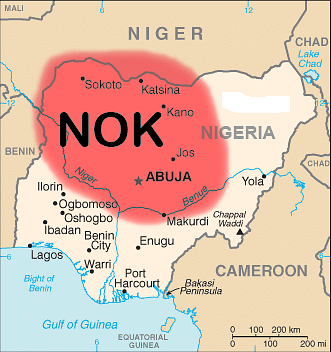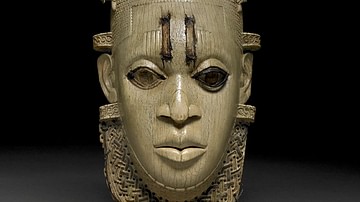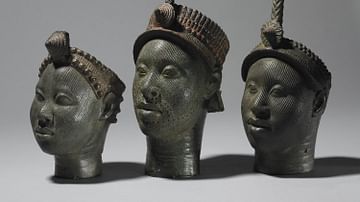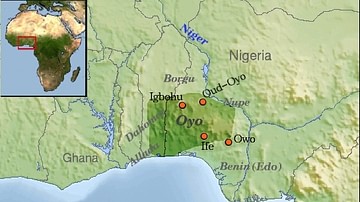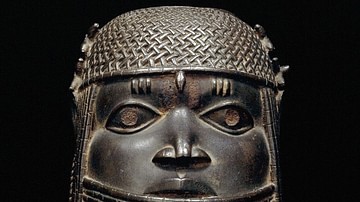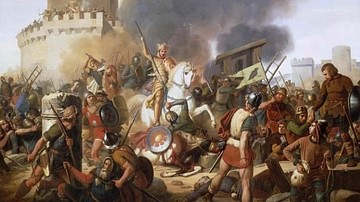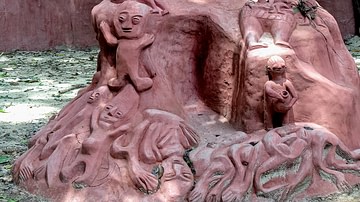
The Nok Culture, named after the settlement of the same name, flourished in southern West Africa (modern Nigeria) during the Iron Age from the 5th century BCE to the 2nd century CE. Famous for the distinctive terracotta sculptures of human heads and figures, Nok was the first known culture in West Africa to produce such art and perhaps the first sub-Saharan culture to perfect iron-smelting technology.
Iron Age Culture
Located east of the Niger River and north of the Benue River in what is today northern and central Nigeria, the Nok culture is named after the town where the first artefacts were discovered. These were mostly fragmentary sculptures, buried under some 8 metres (26 ft) of sand and earth, which were tossed up during local mining operations for tin in the first half of the 20th century CE. The Nok culture prospered thanks to iron-smelting technology which permitted the manufacture of iron tools. Nok culture provides the earliest example of iron-smelting technology in sub-Saharan Africa which may have come from Carthage to the north or, perhaps more likely given the formidable barrier of the Sahara desert, from Nubia in the east. It may even have been an indigenous invention but, unfortunately, there is very little evidence to support any of the three theories above the other two. Wherever the ideas came from, it permitted Nok to jump straight from the Stone Age to the Iron Age and skip the Bronze Age stage that is typical of developments elsewhere.
The remains of perhaps 13 iron-smelting furnaces were discovered at Taruga alone (55 km southeast of Abuja). Durable iron tools such as hoes, hand-axes and cleavers were put to good use to boost agricultural efficiency. Nok farmers were able to grow cereals like sorghum and such vegetables as pumpkins (which were represented in terracotta). Excavations at Taruga revealed the oldest known Nok culture settlement, inhabited between the 4th and 2nd century BCE according to radiocarbon data off charcoal found within the iron furnaces. Despite the arrival of iron technology, stone tools were still used, particularly larger tools, a fact which suggests that metal was always a rare commodity. Nok housing consisted of wattle and daub huts, which do not survive well, but many were built on a foundation consisting of a ring of stones, and these do survive in situ. Archaeology continues in the 21st century CE in the region and is pushing back the time period of the Nok culture, perhaps as early as 900 BCE.
The Nok culture spread through central Nigeria, perhaps covering an area as large as 78,000 square kilometres (30,000 square miles) or approximately the area of Portugal. There are, however, regional differences in both the types of tools and pottery made at various Nok sites. Finds of iron arrow- and spearheads would suggest, too, that life was not always peaceful amongst the Nok and with their rival tribes. The reason for the Nok Culture's decline around 200 CE is not known but is evidenced by a sharp drop in pottery production. The usual culprits may have been overexploitation of natural resources, a period of adverse climate change, civil wars, the arrival of rival kingdoms or a combination of all four.
Nok Sculpture & Pottery
The Nok culture produced sculptures of human heads and figures of humans and animals in terracotta, the earliest such sculpture produced in sub-Saharan Africa. Near life-size terracotta heads were often part of a fuller figure but this portion has usually been lost. Indeed, most terracottas were damaged upon discovery and had been displaced by water action so that their original context is difficult to determine.
When a hollow terracotta figure is fired in an oven, the gases and water vapour which build up and expand within it can cause a figure to crack or even shatter completely. A solution is to make vent holes in the figure and Nok potters did this but with an artistic flare. The eyes, mouth, nostrils, and earholes were all given natural-looking apertures and so the overall aesthetic effect of the figure was not compromised. In contrast to the larger sculptures, smaller figurines are solid.
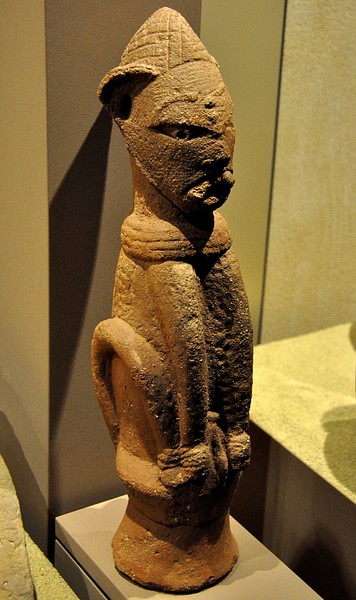
Figures were carved to give features and linear decoration, seemingly when the clay had partially hardened but before firing. Many full figures are seated or standing on a base which represents an upside-down pot. A common posture is a seated figure with one arm resting on one raised knee (as in Auguste Rodin's celebrated 'The Thinker' sculpture). A number of figures carry weapons, but most seem to represent participants in rituals as they sometimes wear particular clothing and almost always a great deal of beaded jewellery and pendants not likely to have been worn every day. Male figures typically have a short square beard and curious moustaches which only grow at the corners of the mouth. There are also a number of figures which are neither human nor purely animals but an imaginative mix of the two. For example, there are humans with a bird-like beak, tail, and legs, and the head of an elephant with very human eyes and forehead.
Nok pottery vessels included shallow bowls with flat bottoms which were decorated on the inside with deeply scored lines, although the scoring may have been to permit the bowl to function as a grater. Chemical analysis of the clay from all Nok pottery shows that it came from the same source (as yet unknown) and so suggests that the industry may have been centralised and under royal control.
Legacy
Nok art, and culture in general, may well have influenced later cultures in the Niger River forest areas, notably Igbo-Ukwu (at its zenith in the 9th century CE) and Ife (11-15th century CE). Certainly, the discovery of the fine artworks produced by the Nok culture provided a helpful precedent that convinced any lingering doubters that the works of those later cultures were indeed that of indigenous black Africans. As archaeology makes its slow and methodical additions to our knowledge and extends the time periods of key West African cultures, then perhaps the at-present tentative links between them will be more firmly established.
